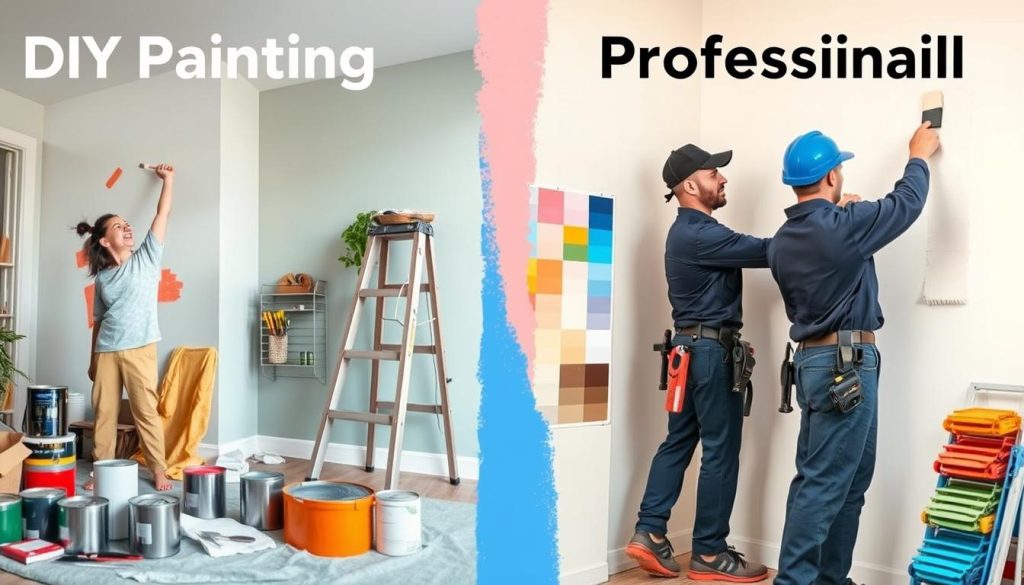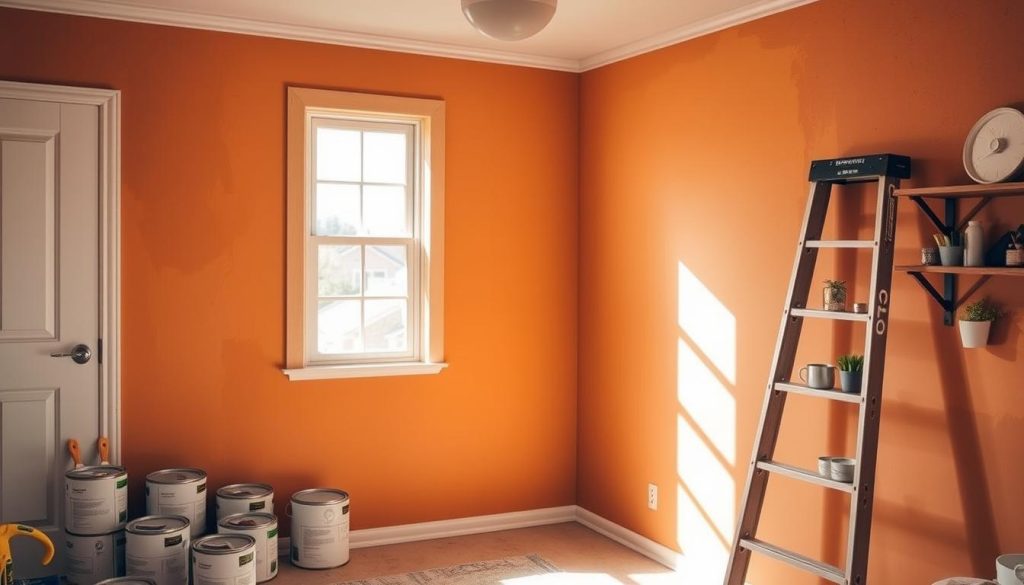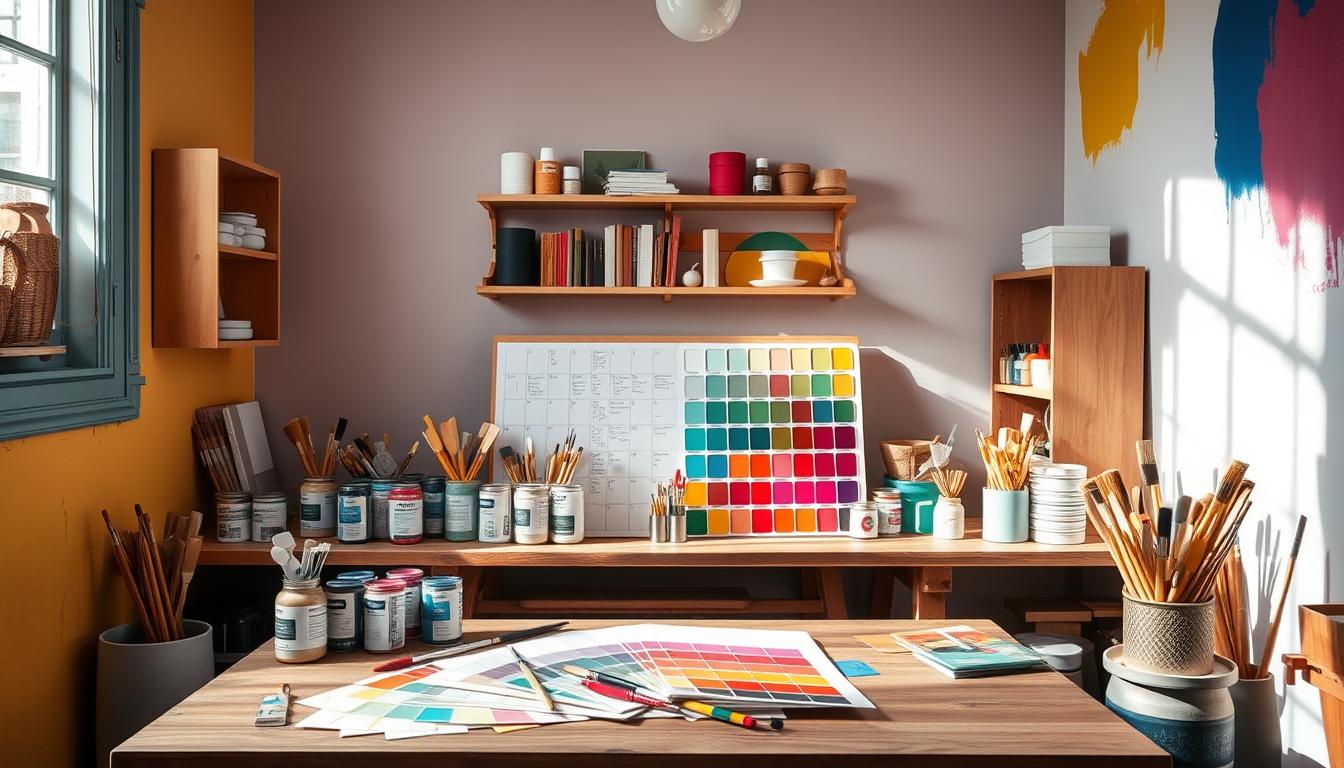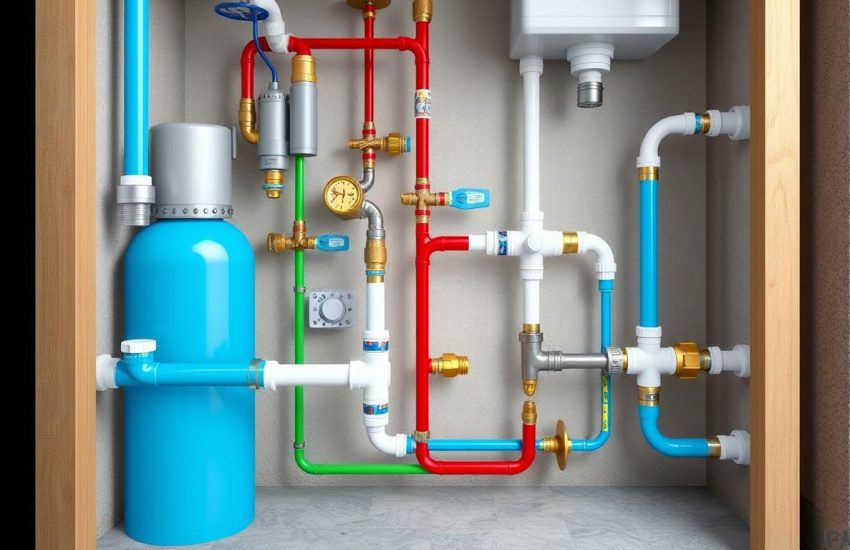Painting Tips: A Complete Guide for Homeowners
Could the key to a good-looking home be in a paintbrush? Mauro Henrique from This Old House thinks so. He says prep work is 85% of a paint job. Whether you want a new color or a big change, we have tips. They range from sanding to picking the right primer. Our guide covers DIY and budget-friendly advice for beautiful results.
Did you know pros don’t like using painter’s tape? It takes too much time. They use special brushes and rollers instead. Starting at the ceiling and ending at the baseboards, they paint with skill. By following Henrique’s advice, painting turns from a task to an art. This makes your space look great.
Paint can really change a place. It has many sheens, like the quiet beauty of flat for ceilings. The right colors can make your home look better and more valuable. It hides old marks and brightens the place. Brands like Sherwin Williams, Benjamin Moore, and Behr offer top-notch paints that transform your home.
Key Takeaways
- The majority of painting success lies in meticulous preparation.
- Techniques and tools like the right sandpaper, brushes, and rollers are foundational for a professional outcome.
- Understanding the order of operations can greatly enhance efficiency and results.
- Choosing the right primer and paint can affect the durability and appearance of your paint job.
- Paint can drastically increase the value and appeal of your home, making it a cost-effective home improvement strategy.
- The right painting method not only looks good but serves a protective purpose for surfaces.
- Costs of painting can vary, but the investment is often returned in the value it adds to your property.
Why Focus on Painting Tips?
For enthusiastic homeowners, painting can make a home look better and increase its value. Learning painting tips for homeowners brings fun and useful results. Doing this makes your space look better and protects it too.
Using resources wisely is key. By choosing the right paint and techniques, you can save money on painting tips. The right tools and methods mean less redoing, making your home look great longer.
Choosing the right paint sheen is important. Flat matte is good for bedrooms. Semi-gloss is better for kitchens and bathrooms because it’s easier to clean.
Painting your home can also make you feel better. It can be like a calming hobby. It lets you express yourself and makes you proud of your home.
Using painting tips for homeowners makes your home nicer. It’s also good for the planet. Picking paints that don’t harm the environment helps everyone. It makes your home safer and healthier.
DIY vs Professional Help
When thinking about home improvement like painting, you face a big choice. Will you follow DIY painting tips or hire professional painting services? Each path has its good and bad points. Knowing these can help you choose what fits your needs, budget, and what you expect.
DIY painting helps save money for those wanting to freshen up their home. But, pros provide skills and speed, giving a top-notch finish that might be hard to do alone.

| Aspect | DIY Painting | Professional Painting Services |
|---|---|---|
| Cost | Lower, costs limited to materials and tools. | Higher, includes labor and high-quality materials. |
| Time and Effort | Significant, requires personal time investment. | Minimal, handled by professionals. |
| Expertise | Limited to individual’s knowledge. | High, professional level understanding and application. |
| Outcome Quality | Variable, risk of imperfections. | Consistently high, with professional guarantees. |
| Equipment and Materials | Basic, often non-professional grade. | Professional grade, access to top brands like Sherwin Williams and Behr. |
DIY projects bring joy and are flexible. Yet, they need lots of time and work. This includes getting ready and cleaning up. Working on old houses might need safety steps best left to pros. On the other hand, professional painting services ease your mind about safety. They offer a smooth process from start to end. They also add design ideas and new trends that make your home look and feel better.
In short, choosing DIY or a pro depends on the project size, your painting skills, and what you hope for the end. Small projects or ones for fun might be good for DIY. But, big projects or those needing special finishes should go to pros. They bring lasting quality and style.
How to Save Money
If you’re painting on a budget, here are some tips to save money. Before starting your home project, think about these cost-saving ideas.

To save on painting, pick high-quality paints. They seem expensive at first but you save on repainting. High-quality paints last longer and save money and time.
| Strategy | Potential Savings |
|---|---|
| Compare three professional estimates | Leverage competitive pricing |
| Paint single accent walls | Reduce costs by focusing on smaller areas |
| Merge paint projects to use uniform paint color | Avoid additional costs of multiple colors |
| Invest in high-quality paints | Decrease frequency of repainting cycles |
| Follow paint brands on social media | Gain access to exclusive sales/promotions |
| Utilize a paint calculator | Buy accurately calculated paint amounts only |
| Reuse and revitalize leftover paints | Minimize waste and purchase of new paints |
For painting on a budget, try a roller squeegee to save paint. Taking care of your tools makes them last longer. This saves money on future projects.
In summary, smart planning and tips help save money. Use promotions and buy quality for better savings.
Step-by-Step Upgrades
Getting professional results from your DIY paint job takes careful planning and doing things right. Here’s a guide full of top painting tips to improve your home.
First steps involve moving or covering furniture and taking off any hardware. This makes sure your workspace is ready. Making the surface smooth is key. By sanding and getting rid of dust, your paint will look better and last longer. Deciding to prime depends on your surface and paint; look at home improvement guides for advice that fits your project.
When painting, it’s best to have a plan. Start at the top with the ceiling and then go to the trim and walls. This helps handle any drips and makes sure paint goes on smoothly. Using a roller or brush depends on the job. Each one needs a special way of handling for the best look.
Using painter’s tape and drop cloths right means clean lines. This is what makes a pro job stand out.
| Component | Function | Recommendation |
|---|---|---|
| Pigments | Provide color and opacity | Choose high-quality pigments for better coverage |
| Solvents | Aids in application | Lesser solvents often imply a higher-quality paint |
| Binders | Helps the paint adhere and form a tough coat | Verify binder type suited for the surface |
| Sheens | Impacts appearance and functionality | Glossier sheens for rooms with moisture; flatter for living areas |
Knowing about paint parts, from pigments to binders, helps get the results you want. Light and room direction matter when picking colors and finishes. For help on paint sheens, look at trusted DIY painting sites.
In the end, following these tips and knowing about materials and how to use them will make your DIY project look and feel better.
Final Tips for Success
Before adding color to your walls, remember, success in home improvement is in the details. Experts suggest prep work is key. This includes sanding for a smooth finish, just like pro painters achieve. Also, buying high-quality paints and brushes makes painting faster and more fun.
Pros might use tinted primer. It helps avoid “flashing” and reduces the need for multiple topcoats. This saves both time and materials. Paint extenders reduce brush marks, giving a clean finish. Pros prefer blue painter’s tape for its sharp lines and easy removal. Remember, canvas drop cloths are best for protecting floors because they soak up spills well.
When painting, tackle one wall at a time. This keeps the color and texture uniform. Don’t worry about painting near windows. Any mistakes can be cleaned up with a razor blade. It takes patience to paint well. Sometimes, painters wait before finishing a job to make sure it’s perfect. If you’re restarting a project or keeping up your home, begin with easier tasks. Look for ideas in art magazines. Finally, to keep walls looking new, clean them regularly and handle wear and tear with care.



